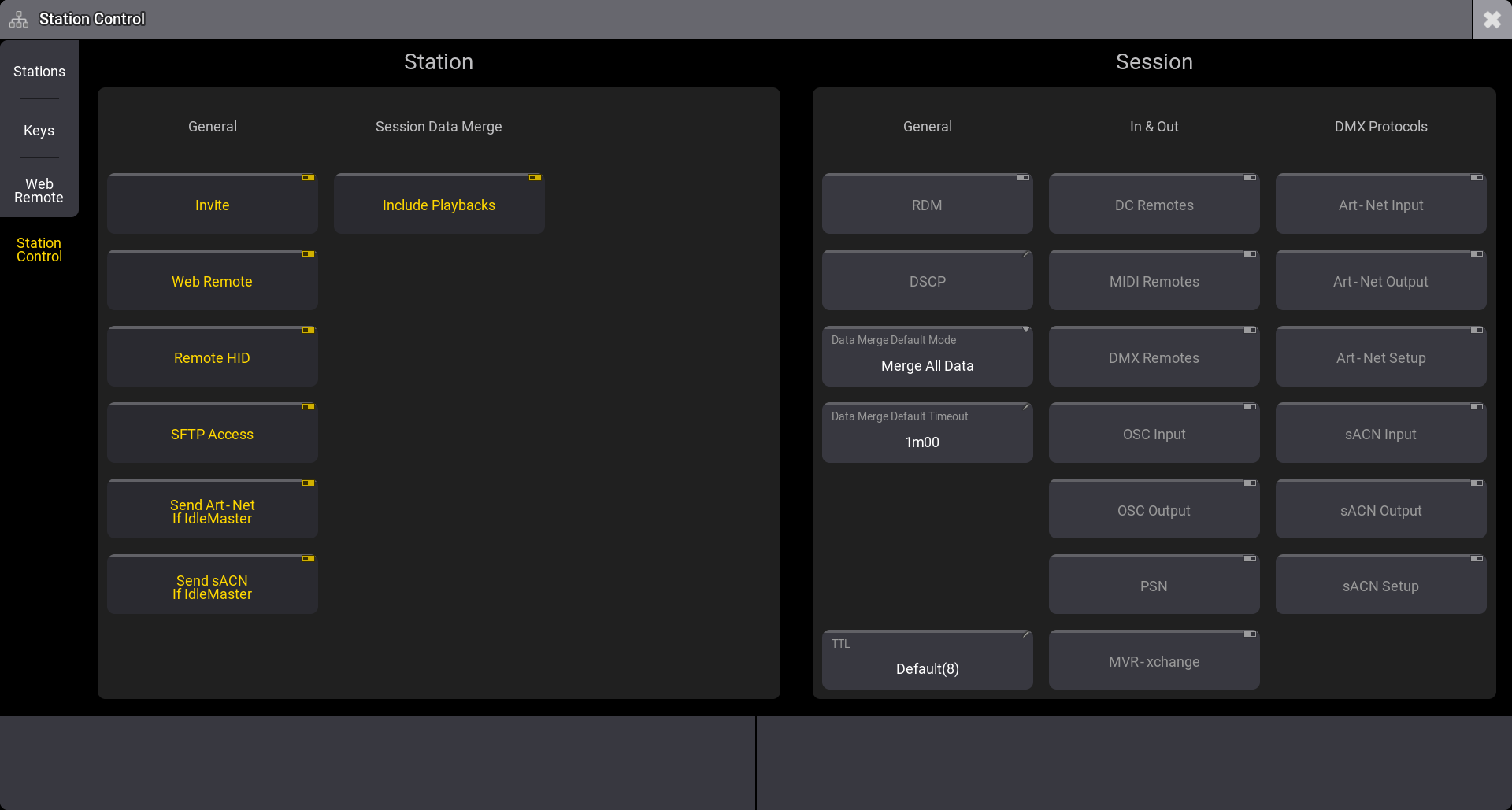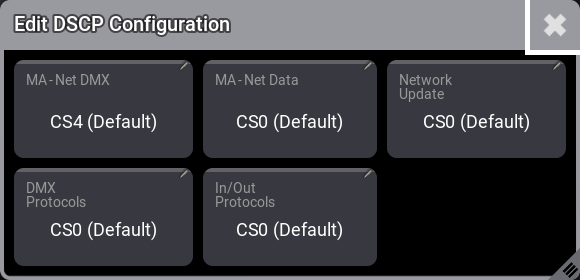Station Control
| grandMA3 ユーザマニュアル » ネットワーキング » Station Control | Version 2.2 |
Station Control メニューを利用すると、ステーションやセッション通信に関する設定にすばやくアクセスできます。
このメニューにある設定の多くは、システムの他の場所にあります。

The menu is split into two sides. The left side is settings related to this specific station. The right side is settings that relate to the entire session.
Station
Station 側には、General および Session Data Merge という2列があります。
General には以下のトグルボタンがあります。
- Invite:
Network メニュー の Invite 設定と同じです。 - Web Remote:
Network メニュー の Web Remote 設定と同じです。 - Remote HID:
Network メニュー の Remote HID 設定と同じです。 - SFTP Access:
SFTP接続によってこのステーションにアクセスできるかどうかを切り替えます。詳しくは SFTP接続 を参照してください。 - Send Art-Net If IdleMaster:
Art-Net メニュー の Send Art-Net If IdleMaster 設定と同じです。 - Send sACN If IdleMaster:
sACN メニュー の Send sACN If IdleMaster 設定と同じです。
Session Data Merge には、トグルボタンが1つだけあります。
- Include Playbacks:
プレイバックの変更を Session Data Merge で考慮するかどうかを指定します。有効にすると変更が考慮されます。
Session Data Merge は、ステーションがセッションに接続するときに発生し、2つのステーションからのデータがマージされます。
Session
Session 側には、General、In & Out、および DMX Protocols という3列があります。
General only has the following buttons:
- RDM:
Network メニュー の RDM 設定と同じです。 - DSCP:
DSCP settings define the Quality of Service (QoS) setting for the data packages. This is information added to the package, and the network switches have settings defining the prioritization of the data packages. Read more below. -
Data Merge Default Mode:
This defines the default data merge mode. This is the preselected option in the Session Data Merge pop-up. This option will be selected when the timeout (read below) expires unless the user manually selects an option. The options are:-
Cancel:
The connecting stations will not join the session of the Master side and be made Standalone. Then, it can be investigated which show file is correct, back up each show file, etc.
- Merge All Data:
Merges the changes of all connecting stations into one show file. -
Keep Only Master Data:
The changes in the show file data of the connecting devices are ignored. The show file of the Master side is maintained. Before overriding the show file of the connecting devices, the show file will be saved automatically on the connecting stations.
This pop-up allows the user to select how data is merged between the session and connecting stations. It is described in the Join a Session topic.
-
Cancel:
-
Data Merge Default Timeout:
This defines the timeout time for the Session Data Merge pop-up. Unlimited is an option. This disables the timeout, and the user must make a manual selection. If the time is set to 0, then the pop-up will not appear and the default mode (see above) is used.This pop-up allows the user to select how data is merged between the session and connecting stations. It is described in the Join a Session topic.
-
TTL (Time To Live):The TTL value specifies the lifespan of an IP packet. Each time the packet passes the next hop (for example, a router or gateway), its TTL is reduced by one, and the packet is discarded when the value reaches zero. Tap TTL and set a value using the calculator. The Default value is "8".
|
|
ヒント |
| Admin rights are needed to change DSCP, Data Merge Default Mode, Data Merge Default Timeout, and TTL. |
In & Out には以下のトグルボタンがあります。
- DC Remotes:
DC Remotes メニュー の Enable Input 設定と同じです。 - MIDI Remotes:
MIDI Remotes メニュー の Enable Input 設定と同じです。 - DMX Remotes:
DMX Remotes メニュー の Enable Input 設定と同じです。 - OSC Input:
OSC メニュー の Enable Input 設定と同じです。 - OSC Output:
OSC メニュー の Enable Output 設定と同じです。 - PSN:
PSN メニュー の Enable Input 設定と同じです。 - MVR-xchange:
MVR メニュー の Enable 設定と同じです。
DMX Protocols には以下のトグルボタンがあります。
- Art-Net Input:
Art-Net メニュー の Art-Net Input 設定と同じです。 - Art-Net Output:
Art-Net メニュー の Art-Net Output 設定と同じです。 - Art-Net Setup:
Art-Net メニュー の Art-Net Setup 設定と同じです。 - sACN Input:
sACN メニュー の sACN Input 設定と同じです。 - sACN Output:
sACN メニューenu の sACN Output 設定と同じです。 - sACN Setup:
sACN メニュー の sACN Setup 設定と同じです。
DSCP
The network data packages from a session are divided into five different categories. Each category has a setting defining the DSCP value. The higher the value, the higher the priority.
Read about the setting above. Editing the DSCP setting opens the Edit DSCP Configuration pop-up.

The five categories are:
- MA-Net DMX
- MA-Net Data
- Network Update
- DMX Protocols
- In/Out Protocols
The different options for each category are:
- CS0 - DSCP Value 0
- CS1 - DSCP Value 8
- AF11 - DSCP Value 10
- AF12 - DSCP Value 12
- AF13 - DSCP Value 14
- CS2 - DSCP Value 16
- AF21 - DSCP Value 18
- AF22 - DSCP Value 20
- AF23 - DSCP Value 22
- CS3 - DSCP Value 24
- AF31 - DSCP Value 26
- AF32 - DSCP Value 28
- AF33 - DSCP Value 30
- CS4 - DSCP Value 32
- AF41 - DSCP Value 34
- AF42 - DSCP Value 36
- AF43 - DSCP Value 38
- CS5 - DSCP Value 40
- Voice-Admit - DSCP Value 44
- EF - DSCP Value 46
- CS6 - DSCP Value 48
- CS7 - DSCP Value 56
It is recommended that the default value be changed only if there is a specific need to do so.
Learn more about DSCP on Wikipedia (external link) or iana.org (external link).
|
|
制限 |
| On grandMA3 onPC for Windows® the DSCP values are overwritten with the default value CS0. |